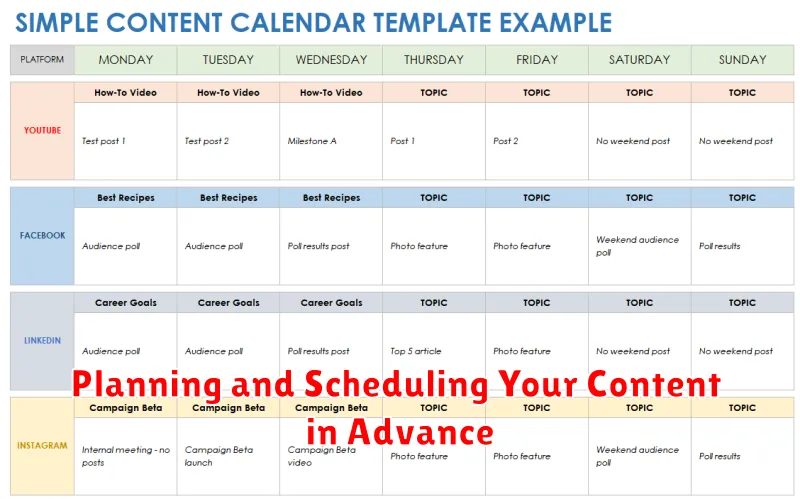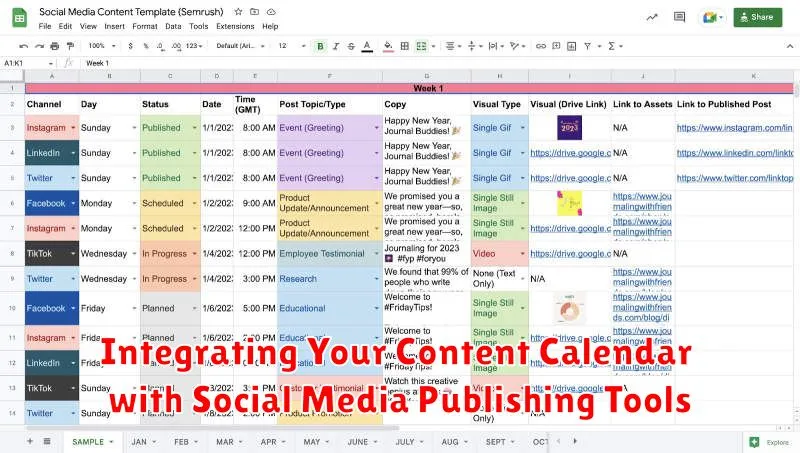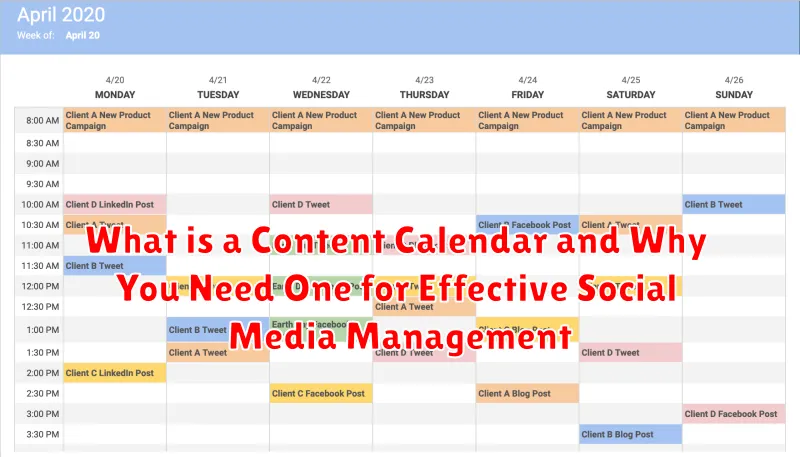In today’s digital landscape, a robust social media presence is crucial for businesses and individuals alike. Effective social media management, however, requires strategic planning and consistent execution. This is where a content calendar comes into play. A content calendar is a powerful tool that empowers you to organize, schedule, and publish your social media content efficiently. It provides a structured approach to social media management, ensuring a consistent brand voice and maximizing your reach. Understanding what a content calendar is and how to use it effectively is essential for achieving your social media marketing goals. Whether you’re a seasoned marketer or just starting out, implementing a content calendar can significantly improve your social media strategy and yield measurable results.
This article will delve into the intricacies of content calendars, explaining what they are, the different types available, and the numerous benefits they offer. We will explore how a content calendar can streamline your social media management workflow, enhance your content strategy, and ultimately, boost your online presence. Learn how to create a content calendar tailored to your specific needs and discover best practices for utilizing it to achieve optimal social media marketing success. By implementing the strategies outlined in this article, you can transform your social media management from reactive to proactive, ensuring consistent engagement and driving meaningful results for your brand or personal platform.
Understanding the Purpose and Benefits of a Content Calendar
A content calendar is a strategic tool used to plan and schedule your social media content. It provides a centralized hub for organizing all your posts, ensuring consistent delivery across different platforms. Think of it as your social media roadmap, guiding your efforts toward achieving your marketing objectives.
The core purpose of a content calendar is to bring organization and efficiency to your social media strategy. By outlining your content in advance, you can avoid last-minute scrambling for posts and maintain a consistent brand presence. This proactive approach allows for more thoughtful content creation and strategic alignment with overall marketing goals.
Using a content calendar brings numerous benefits. It helps you maintain a consistent posting schedule, which is key for audience engagement. It also allows you to plan themed campaigns and capitalize on trending topics more effectively. Furthermore, a content calendar facilitates collaboration among team members, ensuring everyone is on the same page.
Choosing the Right Content Calendar Format for Your Needs
Selecting the right content calendar format is crucial for maximizing its effectiveness. The best format depends on your specific needs, team size, and the complexity of your social media strategy.
Spreadsheets are a simple and accessible option, ideal for individuals or small teams with straightforward content schedules. They offer basic organization and allow for easy collaboration.
If you require more advanced features like task assignments and workflow management, consider using dedicated content calendar software. These tools often provide collaborative features, content approval workflows, and direct integration with social media platforms.
Project management tools can also serve as content calendars, especially for larger teams managing complex campaigns. They facilitate task management, progress tracking, and communication.
Finally, customizable templates offer a flexible solution, allowing you to tailor the calendar to your precise requirements. Whether you prefer a weekly, monthly, or quarterly view, choosing the right format ensures your content calendar aligns with your workflow.
Key Components of an Effective Content Calendar
A well-structured content calendar incorporates key components to ensure its effectiveness. These components allow for organized planning, efficient execution, and tracking of content performance. Including these elements will contribute significantly to a successful social media strategy.
Date and Time: Scheduling posts for optimal visibility is crucial. Specifying the date and time ensures content goes live when the target audience is most active.
Social Media Platform: Clearly identify the intended platform (e.g., Instagram, Twitter, Facebook) for each piece of content. This streamlines publishing and ensures platform-specific formatting.
Content Format: Specify the content type – video, image, text post, article, etc. This helps maintain variety and cater to different audience preferences.
Topic/Theme: Categorizing content by topic or theme ensures a cohesive brand message and facilitates targeted campaigns.
Content Description/Copy: Briefly describe the content’s purpose or include the actual copy. This provides context and ensures clarity for all collaborators.
Keywords/Hashtags: List relevant keywords and hashtags to improve content discoverability and reach a wider audience.
Assigned Team Member: Assign responsibility for content creation and publishing to specific team members for accountability and streamlined workflows.
Status: Track content progress (e.g., drafted, scheduled, published) to maintain an overview of the content pipeline.
Planning and Scheduling Your Content in Advance

Pre-planning your social media content is crucial for maintaining a consistent online presence and maximizing your reach. A content calendar facilitates this by allowing you to map out your posts days, weeks, or even months in advance. This forward-thinking approach eliminates the stress of last-minute content creation and ensures a steady stream of engaging material for your audience.
Scheduling your content through the calendar further streamlines your workflow. By utilizing scheduling features, you can automate the posting process, freeing up valuable time and resources. This allows you to focus on other essential aspects of social media management, such as community engagement and performance analysis. Consistent posting frequency, facilitated by scheduling, reinforces your brand’s presence and keeps your audience engaged.
Consider establishing a content bank of pre-written captions, images, and videos that can be readily deployed when needed. This bank serves as a valuable resource, particularly during busy periods or unexpected events. A well-maintained content bank complements your planned content, ensuring you always have relevant material to share.
Collaborating and Managing Content Creation Workflows
A content calendar facilitates seamless collaboration among content creators, marketers, and other stakeholders. It provides a centralized platform where everyone can view scheduled posts, assigned tasks, and deadlines.
Clearly defined workflows are essential for managing content creation efficiently. A content calendar can outline each step of the process, from ideation and drafting to review and approval.
Assigning roles and responsibilities within the calendar ensures accountability and streamlines the workflow. Team members can see who is responsible for each piece of content and its current status.
Feedback and revisions can be managed directly within the calendar, reducing email clutter and ensuring all changes are tracked. This collaborative approach fosters better communication and ensures content quality.
Integrating Your Content Calendar with Social Media Publishing Tools

A key advantage of using a content calendar lies in its seamless integration with social media publishing tools. This integration streamlines your workflow, saving you valuable time and effort.
Connecting your calendar to platforms like Hootsuite, Buffer, or SproutSocial allows you to schedule posts directly from your calendar. This eliminates the need to manually log in to each platform individually, reducing the risk of missed posting deadlines.
Automated publishing ensures consistent content delivery across all your social media channels. You can pre-schedule posts for optimal times, maximizing reach and engagement. This feature is particularly useful for managing campaigns or recurring content series.
Moreover, integration facilitates collaboration among team members. Multiple users can access and manage the calendar, ensuring everyone stays informed about scheduled content and avoiding duplication of effort.
Analyzing Content Performance and Making Data-Driven Adjustments
A content calendar’s value extends beyond simply scheduling posts. It becomes a powerful tool for analyzing performance and informing future content strategy. Regularly reviewing your content’s performance is crucial for understanding what resonates with your audience and what falls flat.
Track key metrics such as engagement (likes, comments, shares), reach (impressions, followers), and website traffic. Most social media platforms provide built-in analytics dashboards. Use this data to identify top-performing content and understand why it succeeded. Was it the topic, the format, the timing, or a combination of factors?
Conversely, analyze underperforming content. Determine why it didn’t achieve its objectives. Perhaps the topic wasn’t engaging, the timing was off, or the content wasn’t promoted effectively. These insights are invaluable for refining your content strategy.
Based on your analysis, make data-driven adjustments to your content calendar. This might involve creating more content similar to your top performers, experimenting with different formats, adjusting your posting schedule, or revisiting your target audience.
Tips for Maintaining and Optimizing Your Content Calendar
A well-maintained content calendar is crucial for consistent social media success. Regularly review and update your calendar to ensure it remains relevant and effective. Here are some tips to help you:
Schedule Regular Review Sessions: Dedicate time each week or month to review your content calendar. Assess past performance, consider upcoming events, and identify any necessary adjustments.
Stay Flexible and Adapt: Be prepared to adapt your content calendar based on real-time trends and audience feedback. Don’t be afraid to shift scheduled posts or incorporate new ideas.
Keep it Concise: Avoid overcrowding your content calendar. Focus on quality over quantity. A streamlined calendar is easier to manage and more effective.
Utilize Calendar Reminders: Set reminders for upcoming posts to ensure timely publishing. This will help you maintain consistency and avoid missed opportunities.
Regularly Audit Your Content: Periodically analyze your content performance metrics. Identify top-performing content and areas for improvement to refine your future content strategy.

